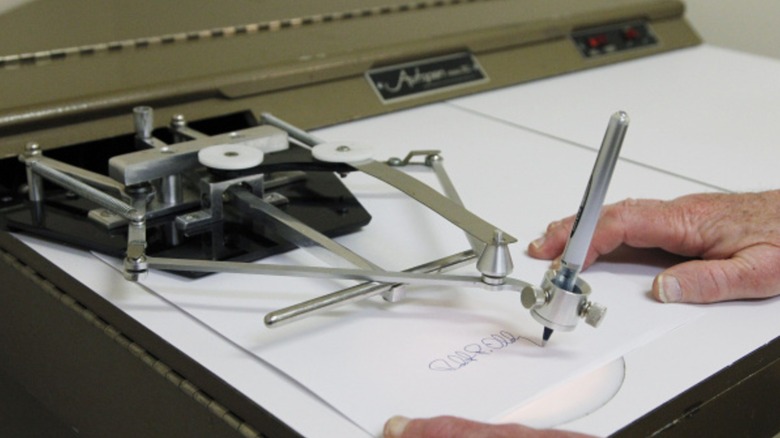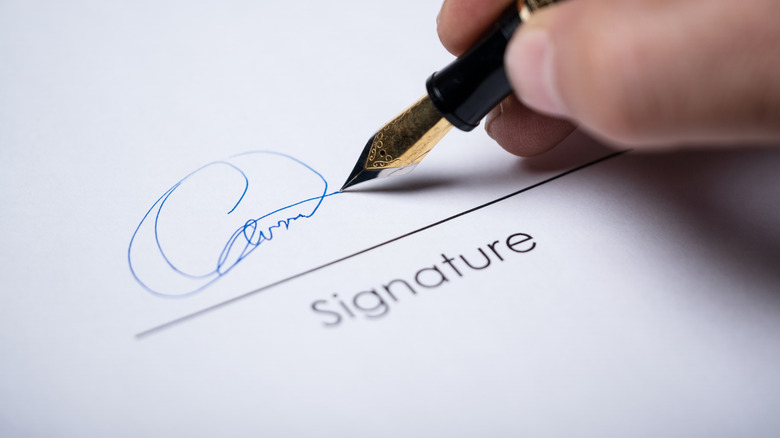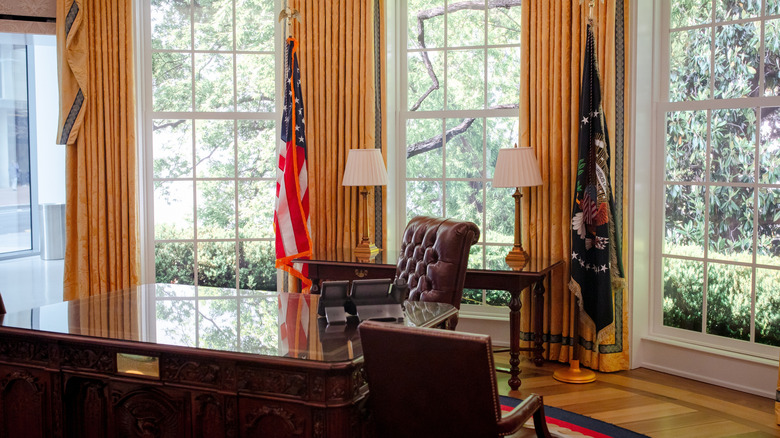What Is An Autopen And Can You Tell If One Has Been Used?
Throughout the past century, numerous tasks once thought to be performed solely by human hands have been offloaded onto technology. Various innovations have drastically altered manufacturing, agriculture, and other labor fields in terms of workflow. Not to mention, numerous revolutionary tech inventions have even been rendered obsolete in recent years by this constant advancement. One that has not quite become commonplace yet, but is quickly becoming well-known anyway, is the autopen, also known as a signing machine. Suffice to say, neither of its names leave much to the imagination in terms of its purpose.
In succinct terms, an autopen — technically a brand-specific name and not the given name of all models ever made — is a machine designed to write a preset signature so an actual person doesn't have to. This is ideal for those in positions like politics, where signing multiple documents per day is the norm, making the entire endeavor a bit easier. Dating back to their origins in the early 1800s, these machines feature a mechanical arm attached to a pen held in place, which applies the preset signature onto whatever is situated below. These machines can be adjusted as needed, from small tweaks in size and shape of the signature to replacing it with a new one entirely.
Seeing as it's a machine replicating a person's signature, there's some apprehension toward autopens. First and foremost amongst worries, is it possible to tell if it has been used in the place of a real person?
Spotting an autopen signature isn't easy
One might think that spotting an autopen-generated signature is as easy as can be. After all, it's a machine replicating a human signature, how accurate can it be? In reality, discerning an autopen signature from a real one isn't super simple. Still, it's not impossible, so long as you know what to look for. The first thing to do is, unsurprisingly, inspect the beginning, as well as look over the end, of the signature. In many cases, there will be a noticeable dot on both ends left behind by the machine. Still, this isn't a guarantee that the signature is from an autopen, nor will all autopen signatures have such features.
There's also the matter of line thickness to look out for. When people write their signatures, there's typically some variation across the signing in line thickness. With an autopen, there's a good chance the generated signature will be relatively uniform in thickness throughout, but much like with the beginning and end dots, this isn't a guaranteed detail. It's also recommended to look at the overall shape of the signature. If it appears unusually shaky, especially when compared to a certified human-written signature, you could have an autopen signature on your hands. Unfortunately, that's the best you're going to get in terms of autopen identification.
Unlike regular pens or cool multifunction pens with built-in gadgets, autopens have garnered some serious controversy in the political arena. The fact is, though, such devices aren't all that new, with a history in politics going back decades.
Autopens are nothing new, especially in politics
Autopens have drawn the ire of many over the years. Though not widely used by celebrities, athletes, and other notable figures, they are used in many cases, or at least enough to put autograph collectors on edge. Autopen signatures are worth far less than real ones, thus devaluing many a prized piece. Meanwhile, autopen technology has made headlines in the political arena. President Donald Trump has made several statements, such as one on Truth Social, regarding his predecessor, former President and longtime Chevrolet Corvette owner Joe Biden, and his alleged use of such devices. Trump claimed that signing pardons and other major documents in this way renders them "VOID, VACANT, AND OF NO FURTHER FORCE OR EFFECT."
What the president should know — something many autograph collectors could corroborate, likely frustratedly — is that autopen use is nothing new for politicians. Rumblings of presidents using them date back to the mid-1900s, with the likes of Harry Truman and Gerald Ford rumored to have used them. Lyndon Johnson, John F. Kennedy, Richard Nixon, and Jimmy Carter reportedly did the same. They aren't nearly as high-profile as Barack Obama's use of autopen technology, signing an extension of the Patriot Act with one in 2011. President George W. Bush's Office of Legal Counsel deemed the procedure legal, too, explaining in a 2005 report that the president doesn't need to sign a document physically for it to be considered valid.
As much controversy as they create, autopens aren't going anywhere. From memorabilia to legislation, odds are they'll continue to see use for years to come.


